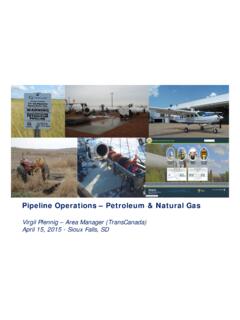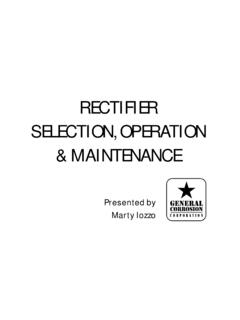Transcription of Determining Class Location
1 Determining Class LocationBuilding Count, Clustering, Boundaries Class locations (a) This section classifies pipeline locations for purposes of this part. The following criteria apply to classifications under this section. (1) A " Class Location unit" is an onshore area that extends 220 yards (200 meters) on either side of the centerline of any continuous 1 mile ( kilometers) of pipeline. (2) Each separate dwelling unit in a multiple dwelling unit building is counted as a separate building intended for human occupancy. Class locations (b) Except as provided in paragraph (c) of this section, pipeline locations are classified as follows: (1) A Class 1 Location is: (i) An offshore area; or (ii) Any Class Location unit that has 10 or fewer buildings intended for human occupancy.
2 (2) A Class 2 Location is any Class Location unit that has more than 10 but fewer than 46 buildings intended for human occupancy. Class locations (3) A Class 3 Location is: (i) Any Class Location unit that has 46 or more buildings intended for human occupancy; or (ii) An area where the pipeline lies within 100 yards (91 meters) of either a building or a small, well defined outside area (such as a playground, recreation area, outdoor theater, or other place of public assembly) that is occupied by 20 or more persons on at least 5 days a week for 10 weeks in any 12 month period. (The days and weeks need not be consecutive.) Class locations (4) A Class 4 Location is any Class Location unit where buildings with four or more stories above ground are prevalent.
3 (c) The length of Class locations 2, 3, and 4 may be adjusted as follows: (1) A Class 4 Location ends 220 yards (200 meters) from the nearest building with four or more stories above ground. (2) When a cluster of buildings intended for human occupancy requires a Class 2 or 3 Location , the Class Location ends 220 yards (200 meters) from the nearest building in the Location Unit Having a single four or more story building within 220 yards of a gas pipeline does not require upgrading to Class 4 requirements because paragraph (e) states in part: "where buildings with four or more stories above ground are prevalent." The use of "prevalent" indicates that they are common or that there are more than one such building in the area.
4 Therefore, a single four or more story building would not cause an area to be designated a Class 4 Location = Mile PostEnd to End Mile the Wrong Wayto do Class 3 Class 11 mile220 yards220 356 Class 1 Class 3 Class Location DeterminationEnd to End Mile the Wrong Wayto do Class 3 Class 1 Class 3 Class 1 Class Location DeterminationEnd to End Mile the Wrong Wayto do Class location5 Continuous Sliding Mile The Right 3 Class 17 Continuous Sliding 3 Class 2 Class 1 Class 2 Class 114 When Class locations overlap, the higher classification 2 Class 356 Class 1 Class 2 Class 3 Class 1 Continuous Sliding MileClass 2 Class 348 Class 1 Class 2 Class 3 Class 3 Class 1 Continuous Sliding MileContinuous Sliding MileClass 2 Class 3 Class 1 Class 2 Class 3 Class 3 Class 2 Class 2 Class 140 Class 224 Class 1 Class 2 Class 3 Class 3 Class 2 Class 2 Class 3 Class 2 Class 1 Continuous Sliding MileClass 212 Class 1 Class 2 Class 3 Class 3 Class 2 Class 2 Class 2 Class 3 Class 2 Class 1 Continuous Sliding MileClass 1 Class 2 Class 1 Class 2 Class 3 Class 35 Class 2 Class 2 Class 2 Class 1 Class 3 Class 2 Class 1 Continuous Sliding MileClass 1 Class 2 Class 3 Class 2 Class 1 Class 1 Class 3 Class
5 1 End to End Mile the Wrong Wayto do Class locationContinuous Sliding Mile - the right way to do Class location19 Adjustment of Class Location Length: Clustering The length of Class locations 2, 3, and 4 may be adjusted as follows: 1) A Class 4 Location ends 220 yards from the nearest building with four or more stories above ground. 2) When a cluster of buildings intended for human occupancy requires a Class 2 or 3 Location , the Class Location ends 220 yards from the nearest building in the 3 (Established by Sliding Mile)220 yards220 yards220 yards220 yardsClass 3 Class 3 Class 3 (Established by Sliding Mile)Clustering220 yards220 yards220 yards220 yardsClass 1 Class 1 Class 3 Class 3 Class 3 (Established by Sliding Mile)Clustering220 yards220 yards220 yards220 yardsClass 1 Class 1 New HouseClass 3 Class 3 (Established by Sliding Mile)Clustering220 yards220 yards220 yards220 yardsClass 1220 yards220 yardsClusteringClusteringClustering Your application of paragraph (f)
6 Of , to restrict the boundaries of Class 2 and Class 3 locations created by a cluster of buildings in otherwise Class 1 situations such as you portray in your drawing is not correct. Because the two clusters portrayed are within a continuous 1 mile length of pipeline, they affect one another and in the example you give would cause the Class Location to be Class 3 to a point of 220 yards beyond the extremities of the two "combined" clusters. 27 Boundary Adjustment of Class locations Two Methods "perpendicular/parallel method" "arc method 28 Arc Method for Adjustment of Class Location Interpretations in #17 & #18 December 1996 Consequently, we ..find both the "arc method" and the "perpendicular/parallel method" to be acceptable for Determining the 220 yard boundary for the cluster of buildings in (f)29 Adjustment of Class locations ( ) with the Perpendicular / Parallel Method220 yd220 ydCLASS 1 Class 2 Class 1 Pipeline Centerline220 yd = 660 ft boundaries220 yard extensionOf Class 2 Segment220 yard extensionOf Class 2 Segment(not to scale)30 Example of Arc Method Application(not to scale)A220 yard = 660 feet boundaryPipelineDwelling A is end of Class 3 Area Yellow Linerepresents length of Class extension - much less than Perpendicular-Parallel Method31 Example of Arc Method Application(not to scale)
7 B220 yard = 660 feet boundaryPipelineDwelling B is end of Class 3 Area -Blue Linerepresents length of Class extension -less than Perpendicular-Parallel Method32 Example of Arc Method Application(not to scale)C220 yard = 660 feet boundaryPipelineDwelling C is end of Class 3 Area -Red Linerepresents length of Class extension as the dwelling or building approaches the center line of the pipeline. The result from the Arc Method approaches the same value as the Perpendicular-Parallel MethodApproximately 220 yards33 Example of Arc Method Application(not to scale)ABC220 yard = 660 feet boundaryPipelineCase 1: Dwelling C is end of Class 3 Area ( A & B are not present): Red Linerepresents length of Class extension Case 2: Dwelling B is end of Class 3 Area ( A & C are not present): Blue Linerepresents length of Class extension Case 3: Dwelling A is end of Class 3 Area ( B & C are not present).
8 Yellow Linerepresents length of Class extension34 Arc Method versus Perpendicular/Parallel Method Difference in Class Extension Length of Extension (ft)Distance from Pipeline (ft)Arc MethodDifference (ft)066066005065866021006526608150643660 1720062966031250611660493005886607233057 2660883505606601004005256601354504836601 7750043166022955036566029560027566038565 0114660546655816605796576366059765936660 62435 Impacts of Increasing to Higher Class locations Frequency Leak Surveys Transmission Line Patrolling Depth of Cover Requirements Design FactorDesign Location123436 Class Location Implication on Calculated Wall Thickness (one example)PDETFSt (in.) , , , , Pressure = 1440 psig, Yield Strength = 65,000 psig, Diameter = 30 in.
9 , E = , T = InterpretationsAnswers to Operator QuestionsAreas within 100 yards April 6, 2007 "For those areas within 100 yards of the pipeline, is the intent of (b)(3)(ii) to include, as Class 3 locations , building(s) such as a convenience store, Circle K, 7 11, etc., and video poker truck stops where persons may frequent on a daily basis?" Yes, the intent of (b)(3)(ii) is to include convenience stores, video poker truck stops and similar buildings in Class 3 locations where these facilities lie within 100 yards of the Persons "What is the interpretation under (b)(3)(ii) as to the 20 persons, such as all 20 present at one time or cumulative throughout the day?" Under (b)(3)(ii), the 20 or more persons must all be present at the same time.
10 However, this does not require the continuous presence of 20 or more people. For example, the minimum requirement is met if 20 people are present at a convenience store at any one time during the day. Four or more stories What is the definition and intent under (b)(4), where it addresses buildings with four or more stories above ground are prevalent ? If you have 10 buildings along a pipeline, a downtown area for example, and 5 or less of the buildings are four or more stories, would this be defined as prevalent and constitute being a Class 4 Location ? In the example you use, ten buildings in a downtown area with five or more buildings four stories or more would meet the definition of prevalent ( , prevailing).





